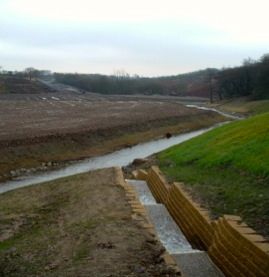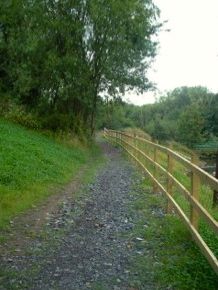The feature picture shows the Kirklees Mill in its glory days, circa 1935.
Woodford Industries acquired the site in 2001 following a spate of incidents involving the death of a school child playing in the remains of the buildings; and several call-outs to the fire brigade to quench burning of tyres. Informal public access was a major concern of the Council’s.
About 400 guests, including members of Bury MBC, were invited to a high profile event and all watched as Fred Dibnah knocked the chimney.

The marquee for the day can be seen on the hillside to the right of the chimney. The weather, though, was severe rain storms and high winds. It seemed at one time as if Thor himself were sending thunderbolts … just as the chimney toppled.

Woodford ran a sweep on the time it would take from lighting the fire at the base of the chimney to the time the chimney fell. Despite insider information, the winner was not a member of our team. It took only 14 minutes or so, whereas Fred reckoned in the mid twenties! Thanks Fred.


Reclamation of the site was made possible through a working partnership with Bury Metro Planning and Environmental Health departments, The Environment Agency Contaminated Land Section and its Rivers & Fisheries Section, Greater Manchester Archaeological Unit & GM Ecological Unit, Bury Angling Club and residential builder, Miller Homes.


Remediation constraints included contaminated ground (heavy metals and hydrocarbons), groundwater and buried asbestos; a flat-bottomed, steep-sided valley with embankment slippages; heavy fly-tipping, relict foundations, old retaining walls and hardstandings.
Contamination specifically involved: the identification of hotspots of hazardous materials, removal of all hazardous source materials off-site, minimisation of waste export, validation of retained soils; monitoring of groundwater & river water quality, monitoring of gas emissions, and regulatory liaison & sign-off in advance of residential development. Stands of Japanese Knotweed were eradicated by spraying.


Major earthworks required raising ground levels above the 1 in 200 year flood level, judicious use of fill, and shaping severe topography to enable residential development.


There was flood potential from Kirklees Brook (a small river) in its canalised channel bisecting the site, and from Sunnywood Reservoir ‘above’ the site. Added to these were ecological constraints and poor access.


The river was completely rerouted along the southern boundary of the site to avoid the need for two new (and expensive) bridges for internal roads. It was set to a gradient and width to minimise flooding potential with several fish resting pools provided along its 300 m course.

Public access was formalised with a new footbridge over the brook.


Sunnywood reservoir water level was lowered to locate and repair leaks and create a bank with a ‘naturalised’ appearance. A cascade overflow system into the re-routed river was constructed to control water levels.

The existing 600m long access road, from the east, was rebuilt to adoptable standards to include a footpath, fully serviced utility corridor and a foul rising main. An emergency access route was provided at the opposite end of the site.


Public Open Space improvements included upgraded woodland footpaths, tree management of its forested surroundings, repairs to other former lodges, improved fishing amenities, additional safety features and enhanced public amenity & access. The undeveloped part of the land holding was given to Bury Metro for use as a Nature Reserve.

In summary, the 10-acre residential development was successful through a joint approach of Woodford as landowner & remediation specialist and a variety of public bodies. Previously derelict and unsafe brownfield land was brought back to beneficial use with better vehicular and pedestrian access, environmental improvements and enhanced amenity value for the whole community.

Overall, a profitable repurposing of a derelict site. An excellent example of real sustainable development.

